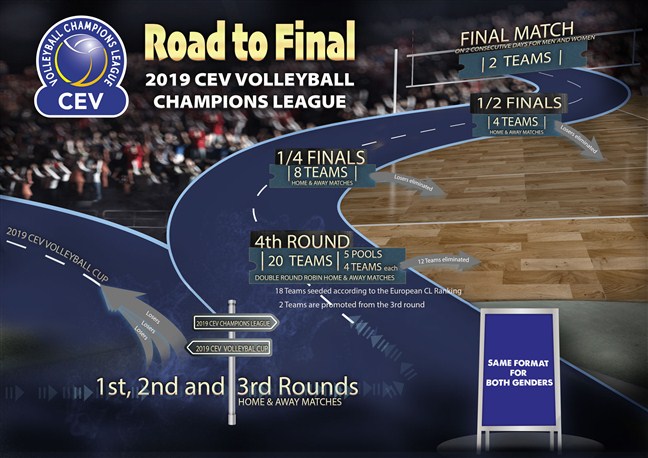25/05/2018 23:20
Major changes to Champions League format to break new ground in Volleyball
2019 CEV Volleyball Champions League - Men & Women
 Luxembourg, May 25, 2018. The 2019 edition of the CEV Volleyball Champions League will break new ground for the sport after the CEV Board of Administration approved earlier this month a number of changes to its format. These reflect the open exchange of views that the CEV had with all relevant stakeholders at the Champions League Forum held back in March in Luxembourg as well as the determination of the CEV’s leadership to deliver an innovative product standing out for its prestige, marketability and value.
Luxembourg, May 25, 2018. The 2019 edition of the CEV Volleyball Champions League will break new ground for the sport after the CEV Board of Administration approved earlier this month a number of changes to its format. These reflect the open exchange of views that the CEV had with all relevant stakeholders at the Champions League Forum held back in March in Luxembourg as well as the determination of the CEV’s leadership to deliver an innovative product standing out for its prestige, marketability and value.
The key changes are the following ones:
• The same number of teams, i.e. 20, will participate in the 4th Round (League Round) of both the men’s and women’s competition, divided into five pools of four each, playing a double round robin. Out of these 20, 18 start their journey straight from the 4th Round to reflect the Champions League Ranking List, and two will progress there through the 1st-2nd and 3rd Rounds. The losers from the 1st, 2nd and 3rd Round fixtures will continue their journey in the 2019 CEV Volleyball Cup.
• The CEV have introduced a new Champions League Ranking, which takes into consideration the performances achieved by all teams from the same National Federation that competed in 2016, 2017 and 2018 editions of Europe’s premier competition. This is to emphasise the status of the CEV Volleyball Champions League as a ‘top product’ and to make sure that the top teams from the strongest national leagues participate in the Champions League. This ranking reflects the investments and performances of all teams representing the same country in Europe’s elite competition. However, to ensure consistency with the policy adopted for the 2017 and 2018 editions, the winners of each National Federation’s league remain eligible to register and to participate in the CEV Volleyball Champions League. Click here to retrieve the relevant ranking as well as the allocation of spots for each National Federation.
• The seeding of 18 teams in the 4th Round will reflect the quality of their performance on the court as well as their investments in Volleyball and in the delivery of an elite product. As for the previous rounds, the level of competition will be fairer, thus increasing the chances for teams from the lower-ranked National Federations to progress to the 4th Round.
• After completion of the 4th Round, 8 teams will continue their journey in the quarterfinals, whose eventual winners will contest the semi-finals. Both the quarterfinals and semi-finals will feature home and away matches.
• A single match, a ‘grand finale’ whose winners take it all, replaces the Final Four in each gender. The CEV will now conduct an open and competitive bidding process to select the neutral host of this ‘ultimate Volleyball show’ in 2019, 2020 and 2021. In a major change compared to the past, no team will progress straight to the final stage of the competition after gaining the hosting rights for the event. The ‘grand finale’, due to take place in one venue on two consecutive days, will allow long-term planning and appropriate promotion of the event, increase international and media public attention and account for a ‘total Volleyball experience’ that fans will never forget.
“During its last meeting held in Kazan earlier this month, the CEV Board of Administration took some very important decisions for the future of our sport and our institution,” CEV President Aleksandar Boričić says. “The CEV is increasing its investment on all levels, with a focus on top events, taking Volleyball to unprecedented levels in terms of promotion, branding and social media coverage, while increasing the prize money as well. These changes reflect the productive discussions we had with all relevant stakeholders at the Champions League Forum we hosted back in March for the first time ever. I am extremely proud to say that thanks to the CEV’s efforts and working together as one team, we are opening a new era for Volleyball in Europe.”
|